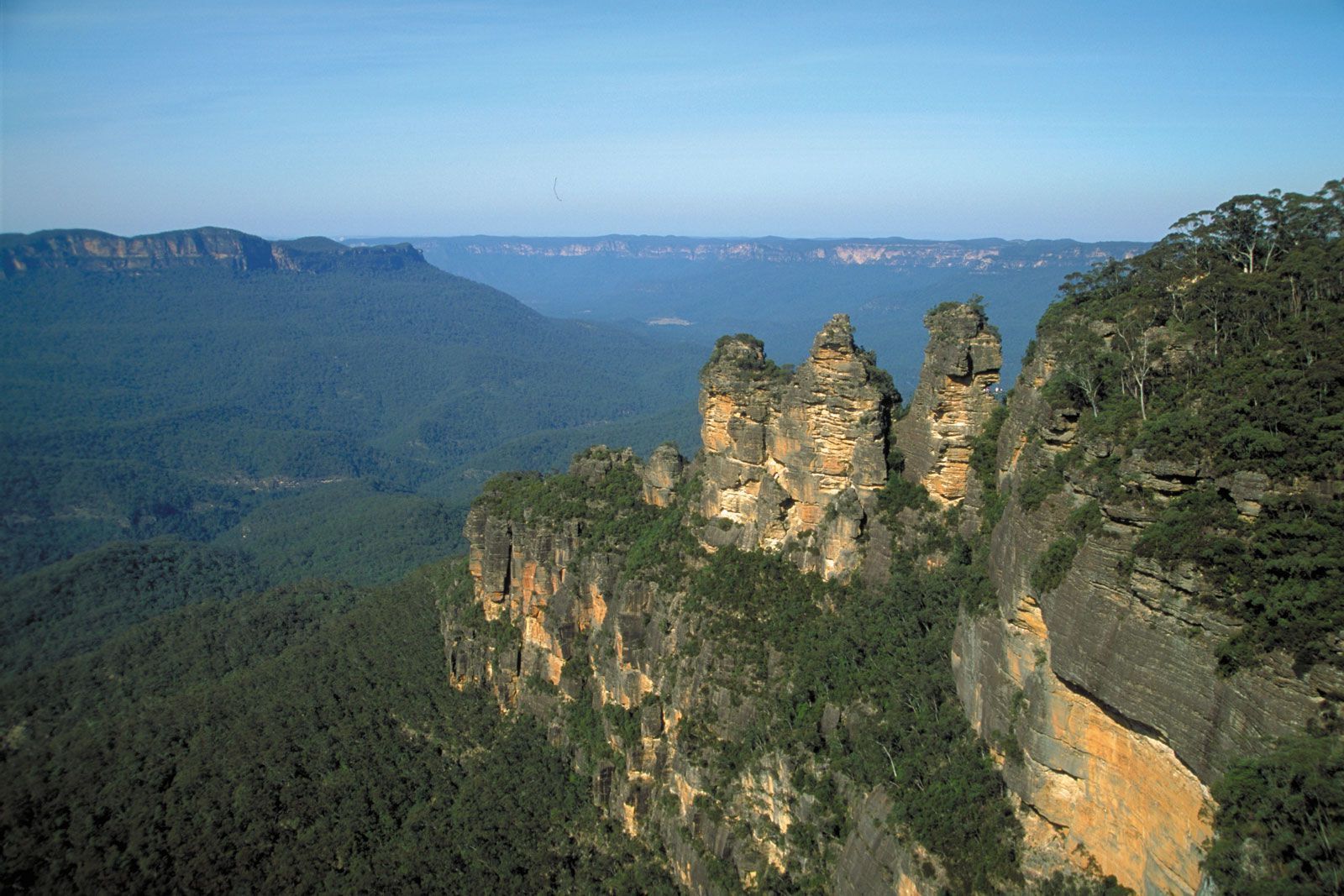
Why are the Blue Mountains called the Blue Mountains? The Blue Mountains, located in eastern New South Wales, Australia, get their name from the blue haze that blankets the landscape when viewed from a distance. This striking phenomenon is caused by the scattering of sunlight through tiny droplets of eucalyptus oil released by the abundant eucalyptus trees in the area. These mountains are not just a visual marvel; they are a treasure chest of geological history, unique flora and fauna, and rich cultural heritage. From ancient rock formations to vibrant local communities, the Blue Mountains offer a blend of natural beauty and historical significance that captivates millions of visitors each year.
Key Takeaways:
- The Blue Mountains in Australia are ancient, with unique flora and fauna, and offer stunning natural attractions. It's a top tourist destination generating millions in revenue annually.
- The region holds significant cultural and historical importance, with rock art and carvings left by the Aboriginal people. Conservation efforts aim to protect this natural wonder.
The Blue Mountains: A Natural Wonder
The Blue Mountains in New South Wales, Australia, are a stunning blend of natural beauty, rich history, and unique flora and fauna. Let's dive into some fascinating facts about this incredible region.
-
Name Origin: The Blue Mountains get their name from the blue haze that blankets them. This haze is due to the scattering of sunlight by tiny droplets of eucalyptus oil in the air.
-
Age: These mountains are ancient, with rocks dating back around 470 million years. They are about ten times older than the Grand Canyon.
-
Geological Formation: Part of the Great Dividing Range, the Blue Mountains are a sandstone plateau formed about 50 million years ago after a significant uplift.
-
Discovery: European explorers Gregory Blaxland, William Lawson, and William Charles Wentworth first discovered the Blue Mountains in 1813, opening the region to further exploration and settlement.
National Park and Walking Trails
The Blue Mountains National Park is a haven for nature lovers and adventure seekers. It offers a variety of trails and breathtaking scenery.
-
National Park: Established in 1959, the Blue Mountains National Park covers 2,690 square kilometers and is a UNESCO World Heritage Site.
-
Walking Trails: With over 140 kilometers of walking trails, the park offers everything from short strolls to week-long treks. Notable trails include the Six Foot Track, National Pass, and Grand Canyon Walk.
-
Tourist Attraction: Attracting over three million visitors annually, the Blue Mountains are a top tourist destination in Australia, generating around $250 million each year.
Unique Flora and Fauna
The Blue Mountains are home to a variety of unique plants and animals, some of which can't be found anywhere else in the world.
-
Unique Plants: Over 150 unique plant species thrive here, including the Thismia megalongensis, an orange flower discovered in 2015 that smells like fungus and rotting fish.
-
Unique Fauna: The region is home to animals like the eastern brushtail possum and the spotted-tailed quoll, which are found nowhere else on Earth.
-
Eucalyptus Forests: The expansive eucalyptus forests are the primary source of the blue haze. Eucalyptus oil droplets, dust, and water vapor create this distinctive color.
Historical and Cultural Significance
The Blue Mountains hold significant cultural and historical importance, especially for the Aboriginal people who have lived there for thousands of years.
-
Aboriginal Heritage: The Gundungurra and Darug people have left behind rock art and carvings that tell their stories and history.
-
Historical Settlement: Initially a retreat for wealthy Sydney residents, the Blue Mountains are now a popular tourist area accessible by good roads.
-
Townships: The region is home to over 27 towns, including Leura, Wentworth Falls, and Glenbrook, each offering scenic beauty and local culture.
Scenic Attractions
The Blue Mountains are filled with stunning natural attractions that draw visitors from around the world.
-
Scenic Railway: The Scenic Railway at Scenic World is the steepest railway in the world, originally used for mining in 1878.
-
Jenolan Caves: Located on the edge of the Blue Mountains, these caves offer a unique experience and contribute to the region’s natural and cultural significance.
-
Canyons: With over 900 canyons, the Blue Mountains offer deep and narrow gorges that add to the region’s natural beauty.
Climate and Weather
The Blue Mountains experience a variety of weather conditions, adding to their unique charm.
-
Snowfall: Snow is rare, falling only once or twice during an average winter. Climate change and population growth contribute to this rarity.
-
Highest Point: Mount Werong is the highest point in the Blue Mountains, standing at an elevation of 1,215 meters.
-
Rayleigh Scattering: The blue tinge seen from a distance is due to Rayleigh scattering, where sunlight is scattered by particles in the atmosphere.
Conservation and Modern Life
Efforts to preserve the Blue Mountains' natural beauty and cultural significance continue to this day.
-
Conservation Efforts: Recognized as Australia’s 14th World Heritage Site in 2000, ongoing conservation efforts aim to protect this natural wonder.
-
Population Growth: The City of Blue Mountains, formed in 1947, has seen rapid urban growth, with a population of 75,942 in 2011.
-
Creative Hub: Nearly 8% of the local population works in creative industries, including writers, artists, and musicians, contributing significantly to the local economy.
-
Economic Impact: Tourism generates hundreds of millions in revenue each year, making it a significant contributor to the local economy.
-
Ghost Tours: For those interested in the paranormal, ghost tours explore eerie legends and sightings, including black panther sightings and UFO reports.
-
Lost Hikers: Despite the beauty, more than 100 people get lost each year. Most are found safe within a day, thanks to rescue efforts.
Geological and Natural Features
The Blue Mountains' unique geological features and natural resources make them a fascinating study.
-
Geological Diversity: The region features sandstone plateaus, valleys, and canyons, influencing human history from Native American settlements to modern tourism.
-
Bedrock Formation: The bedrock consists of three main parts: the basement complex, granitic intrusive rock, and younger volcanic and sedimentary rock.
-
Glacial Activity: Glaciers have shaped the Blue Mountains, leaving behind deposits of till in the Wallowa and Greenhorn Mountains.
-
Timber Harvesting: By the mid-1920s, timber harvesting had become a significant industry, with Grant County producing over 22 million board feet of lumber in 1925.
-
Geothermal Resources: The region contains geothermal resources, including hot springs that attract tourists and provide heating support to buildings.
Aboriginal and Early Settlements
The Blue Mountains have been home to various Native American tribes and early European settlers.
-
Native American Settlements: Tribes like the Cayuse, Umatilla, and Nez Perce lived in the region for millennia, practicing seasonal rounds of hunting and gathering.
-
Agricultural Fires: The name "Blue Mountains" also comes from the smoke cast by agricultural fires used by Native Americans to clear underbrush and enhance food production.
-
Confederated Tribes: The Cayuse, Umatilla, and Nez Perce are part of the Confederated Tribes of the Umatilla Indian Reservation, headquartered in Pendleton.
-
Historical Significance: The Blue Mountains have significant cultural and historical importance, with rock art and carvings left by the Gundungurra and Darug people.
Modern Attractions and Activities
Today, the Blue Mountains offer a range of activities and attractions for visitors.
-
Botanic Garden: The Blue Mountains Botanic Garden is the only one in Australia located within a UNESCO World Heritage Area, showcasing unique regional flora.
-
Walking Tracks Length: The walking tracks cover approximately 250 kilometers, providing ample opportunities for exploration and adventure.
-
Principal Centers: Key towns like Katoomba, Leura, and Blackheath are located along the rail line and Great Western Highway between Sydney and Lithgow.
-
Creative Industries: The region is a hub for creative industries, with nearly 8% of the local population working in fields like writing, art, and music.
-
Ghost Legends: The Blue Mountains are steeped in ghost legends and sightings, adding to the region’s mystique.
-
Lost Hikers Rescue: Many lost hikers are rescued each year, with most found safe within a day, thanks to dedicated rescue efforts.
The Blue Mountains: A Natural Marvel
The Blue Mountains are a stunning blend of ancient geology, rich cultural history, and unique flora and fauna. From the striking blue haze caused by eucalyptus oils to the steepest railway in the world, this region offers endless wonders. With over 150 unique plant species and 900 canyons, there's always something new to explore. The area's Aboriginal heritage adds a layer of historical significance, making it more than just a pretty landscape. Whether you're trekking one of the 250 kilometers of walking tracks or visiting the Jenolan Caves, the Blue Mountains promise an unforgettable experience. The region's creative community and ghost legends add even more charm. Conservation efforts ensure this natural marvel remains pristine for future generations. So, pack your bags and get ready to be amazed by the Blue Mountains' breathtaking beauty and rich history.
Frequently Asked Questions
Was this page helpful?
Our commitment to delivering trustworthy and engaging content is at the heart of what we do. Each fact on our site is contributed by real users like you, bringing a wealth of diverse insights and information. To ensure the highest standards of accuracy and reliability, our dedicated editors meticulously review each submission. This process guarantees that the facts we share are not only fascinating but also credible. Trust in our commitment to quality and authenticity as you explore and learn with us.


